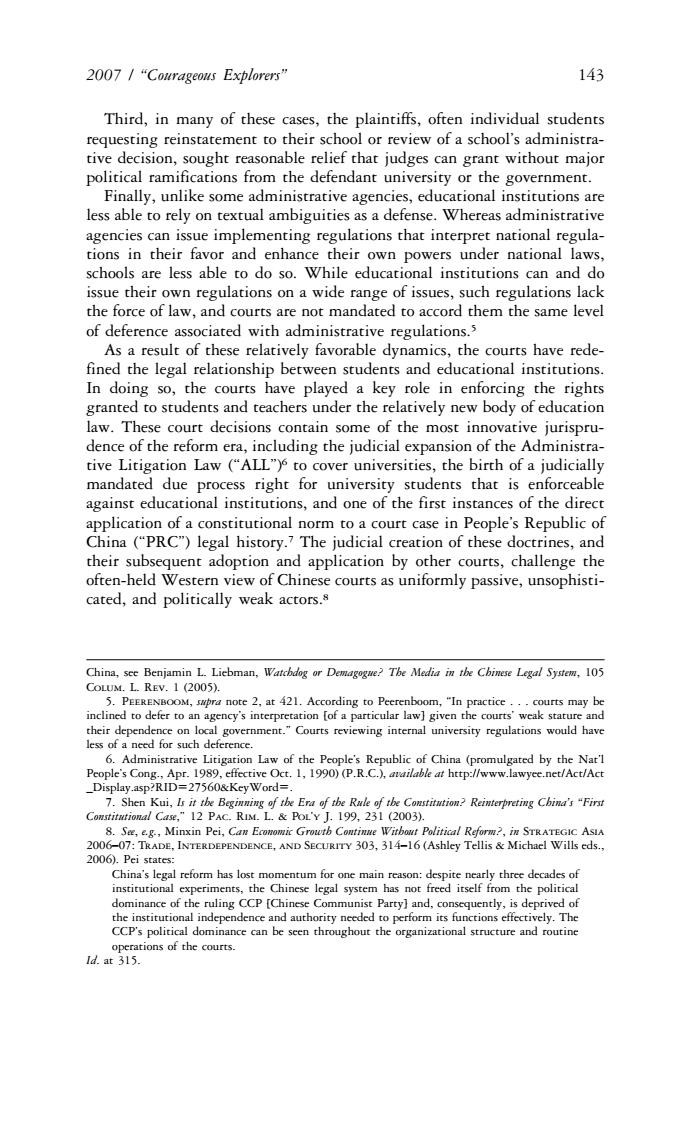正在加载图片...

2007/“Courageous Explorers” 143 Third,in many of these cases,the plaintiffs,often individual students requesting reinstatement to their school or review of a school's administra- tive decision,sought reasonable relief that judges can grant without major political ramifications from the defendant university or the government. Finally,unlike some administrative agencies,educational institutions are less able to rely on textual ambiguities as a defense.Whereas administrative agencies can issue implementing regulations that interpret national regula- tions in their favor and enhance their own powers under national laws, schools are less able to do so.While educational institutions can and do issue their own regulations on a wide range of issues,such regulations lack the force of law,and courts are not mandated to accord them the same level of deference associated with administrative regulations.3 As a result of these relatively favorable dynamics,the courts have rede- fined the legal relationship between students and educational institutions. In doing so,the courts have played a key role in enforcing the rights granted to students and teachers under the relatively new body of education law.These court decisions contain some of the most innovative jurispru- dence of the reform era,including the judicial expansion of the Administra- tive Litigation Law ("ALL")6 to cover universities,the birth of a judicially mandated due process right for university students that is enforceable against educational institutions,and one of the first instances of the direct application of a constitutional norm to a court case in People's Republic of China("PRC")legal history.7 The judicial creation of these doctrines,and their subsequent adoption and application by other courts,challenge the often-held Western view of Chinese courts as uniformly passive,unsophisti- cated,and politically weak actors.s China,see Benjamin L.Liebman,Watcbdog or Demagogue?The Media in the Chinese Legal System,105 COLUM.L.REV.1 (2005). 5.PEERENBOOM,swpra note 2,at 421.According to Peerenboom,"In practice...courts may be inclined to defer to an agency's interpretation [of a particular law]given the courts'weak stature and their dependence on local government."Courts reviewing internal university regulations would have less of a need for such deference. 6.Administrative Litigation Law of the People's Republic of China(promulgated by the Nat'l People's Cong.,Apr.1989,effective Oct.1,1990)(P.R.C.),ailble at http://www.lawyee.net/Act/Act _Display.asp?RID=27560&Key Word=. 7.Shen Kui,Is it the Beginning of tbe Era of tbe Rule of tbe Constitution?Reinterpreting China's"First Constitutional Case,"12 PAC.RIM.L.PoL'Y J.199,231 (2003). 8.Se,eg,Minxin Pei,Can Economic Growth Continue Without Political Reform?,in STRATEGIC ASA 2006-07:TRADE,INTERDEPENDENCE,AND SECURITY 303,314-16 (Ashley Tellis Michael Wills eds., 2006).Pei states: China's legal reform has lost momentum for one main reason:despite nearly three decades of institutional experiments,the Chinese legal system has not freed itself from the political dominance of the ruling CCP [Chinese Communist Party]and,consequently,is deprived of the institutional independence and authority needed to perform its functions effectively.The CCP's political dominance can be seen throughout the organizational structure and routine operations of the courts. Id.at 315.\\server05\productn\H\HLH\20\HLH2001.txt unknown Seq: 3 12-JUN-07 16:27 2007 / “Courageous Explorers” 143 Third, in many of these cases, the plaintiffs, often individual students requesting reinstatement to their school or review of a school’s administrative decision, sought reasonable relief that judges can grant without major political ramifications from the defendant university or the government. Finally, unlike some administrative agencies, educational institutions are less able to rely on textual ambiguities as a defense. Whereas administrative agencies can issue implementing regulations that interpret national regulations in their favor and enhance their own powers under national laws, schools are less able to do so. While educational institutions can and do issue their own regulations on a wide range of issues, such regulations lack the force of law, and courts are not mandated to accord them the same level of deference associated with administrative regulations.5 As a result of these relatively favorable dynamics, the courts have redefined the legal relationship between students and educational institutions. In doing so, the courts have played a key role in enforcing the rights granted to students and teachers under the relatively new body of education law. These court decisions contain some of the most innovative jurisprudence of the reform era, including the judicial expansion of the Administrative Litigation Law (“ALL”)6 to cover universities, the birth of a judicially mandated due process right for university students that is enforceable against educational institutions, and one of the first instances of the direct application of a constitutional norm to a court case in People’s Republic of China (“PRC”) legal history.7 The judicial creation of these doctrines, and their subsequent adoption and application by other courts, challenge the often-held Western view of Chinese courts as uniformly passive, unsophisticated, and politically weak actors.8 China, see Benjamin L. Liebman, Watchdog or Demagogue? The Media in the Chinese Legal System, 105 COLUM. L. REV. 1 (2005). 5. PEERENBOOM, supra note 2, at 421. According to Peerenboom, “In practice . . . courts may be R inclined to defer to an agency’s interpretation [of a particular law] given the courts’ weak stature and their dependence on local government.” Courts reviewing internal university regulations would have less of a need for such deference. 6. Administrative Litigation Law of the People’s Republic of China (promulgated by the Nat’l People’s Cong., Apr. 1989, effective Oct. 1, 1990) (P.R.C.), available at http://www.lawyee.net/Act/Act _Display.asp?RID=27560&KeyWord=. 7. Shen Kui, Is it the Beginning of the Era of the Rule of the Constitution? Reinterpreting China’s “First Constitutional Case,” 12 PAC. RIM. L. & POL’Y J. 199, 231 (2003). 8. See, e.g., Minxin Pei, Can Economic Growth Continue Without Political Reform?, in STRATEGIC ASIA 2006–07: TRADE, INTERDEPENDENCE, AND SECURITY 303, 314–16 (Ashley Tellis & Michael Wills eds., 2006). Pei states: China’s legal reform has lost momentum for one main reason: despite nearly three decades of institutional experiments, the Chinese legal system has not freed itself from the political dominance of the ruling CCP [Chinese Communist Party] and, consequently, is deprived of the institutional independence and authority needed to perform its functions effectively. The CCP’s political dominance can be seen throughout the organizational structure and routine operations of the courts. Id. at 315